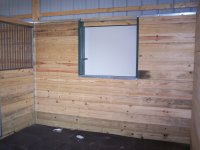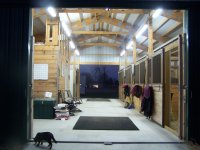You want a concrete aisleway, concrete office/tackrood/feedroom floor, concrete aprons at the doors (heavily grooved for traction) and blue clay stall floors. The blue clay has hoof friendly antibacterial content that aids hoof infection fighting (no hoof, no horse). Yes, concrete stall floors would stay flat, but rubber mats or sawdust or shavings on concrete trap/retains urine/uric acid. Acid and concrete are like matter and antimatter. Plus standing on a rigid surface is bad for horse leg ligaments and contributes to lameness.
I suggest you consider a wash stall, too. Also with a floor drain and block walls and a concrete floor. This is the way my barn has been professional designed, then built by a fellow who owned a concrete company. Even the stall walls are concrete block. No chewing through these walls. We had extra stalls, so I rotated the horses between them. This allows the stalls to dry out during the swap.
BTW, I made my own stall bedding using a wood chipper and anything pine that will go into it. Used and thrown out Christmas trees make the best chips. Smells like a PINE forest. Easy to sift through and easy to burn when the time comes (smells like burning cork).
While your barn is still in the construction phase, think about where you will be storing hay for winter or year 'round feeding. Don't store it above stalls because the critters give off a LOT of moisture/sweat. This will rise above the occasion and your hay will get moldy.
I have a few other practical suggestions in terms of barn management and efficient use of your time, but I don't want you to choke on these.
I suggest you consider a wash stall, too. Also with a floor drain and block walls and a concrete floor. This is the way my barn has been professional designed, then built by a fellow who owned a concrete company. Even the stall walls are concrete block. No chewing through these walls. We had extra stalls, so I rotated the horses between them. This allows the stalls to dry out during the swap.
BTW, I made my own stall bedding using a wood chipper and anything pine that will go into it. Used and thrown out Christmas trees make the best chips. Smells like a PINE forest. Easy to sift through and easy to burn when the time comes (smells like burning cork).
While your barn is still in the construction phase, think about where you will be storing hay for winter or year 'round feeding. Don't store it above stalls because the critters give off a LOT of moisture/sweat. This will rise above the occasion and your hay will get moldy.
I have a few other practical suggestions in terms of barn management and efficient use of your time, but I don't want you to choke on these.




